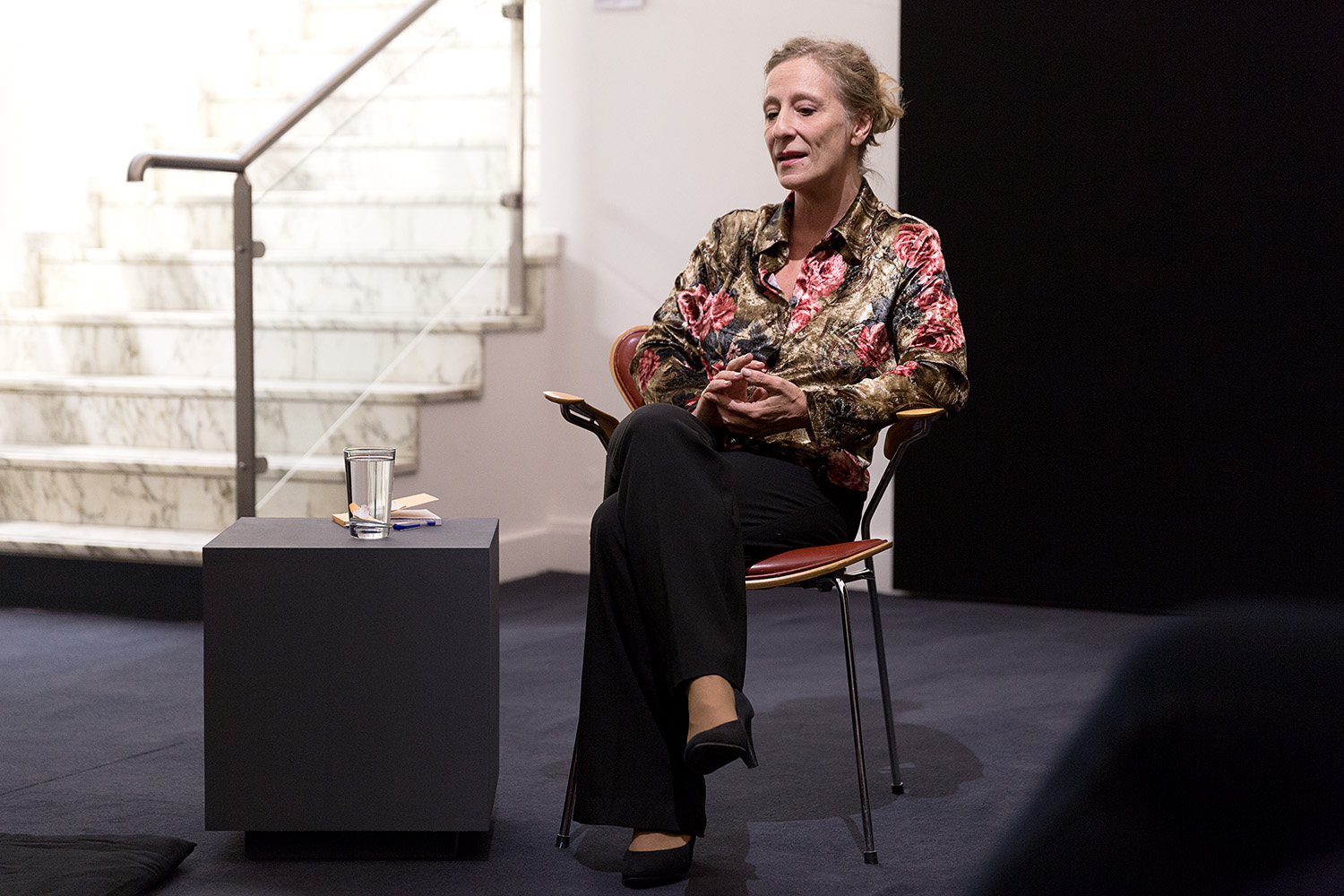Eszter Salamon 1949
This work was created on the occasion of the exhibition Eszter Salamon 1949 presented in 2014 as part of the seventh edition of the Jeu de Paume Satellite program entitled “Tales of Empathy” entrusted to the independent curator Nataša Petrešin-Bachelez .
How can an encounter with someone whose existence is none of your concern take place as an exhibition? What does it lead to and what feelings of sympathy, identi cation or empathy do visitors experience? Using fiction, documentary, video, music and sound as part of her extended choreographic practice, Eszter Salamon conceived the performative exhibition Eszter Salamon 1949 as a continuation of her previous project, the solo Melodrama (2012). In this earlier documentary performance, she staged the life of a namesake she had met in 2006, who was born in 1949 and who today lives in a Hungarian village. For this work, she conducted a series of interviews with this woman between 2006 and 2012. By playing the role of the double in this first piece, the choreographer rethought both the medium and the material, the unique body and the speech that serves to circumscribe it; a body – my body – a vacant space, an unknown territory given individual identity b a name, a jumble of memories, facts, sensations.
The fourth part of the Jeu de Paume’s Satellite Programme 7 “Tales of Empathy”, Eszter Salamon 1949 is conceived for a precise space and
time within the logic of an exhibition. Extending her previous work on homonyms and female autobiography, it takes the form of a continuous live exhibition for three actresses. Performance, documentary work and auto-fiction are combined to create a vehicle for multiple perspectives on the fragile and permeable construction of identity and its performativity. For a period of four weeks and for six hour a day during opening times, the Jeu de Paume will resound with the voice and with the echoes of this diffracted, amplified life, identity within identity. Reciting the words exchanged between one Eszter Salamon and another, the actresses, one at a time, will embody these subjective snippets in which a chance name comes up against historic 20th-century events and anecdotes.
The work explores a variety of questions: To what extent do we edit our own lives? What is reality and what is fiction? What is memory and what is imagination or interpretation? How does an older woman deal with her own past?
The project thereby aims to create an “intimate public.” In her book “The Female Complaint,” Lauren Berlant writes about intimacy in a public sphere, arguing that the “intimate public” is based on “an expectation that the spectators of a particular event, text or experience already share a worldview and emotional knowledge that they have derived from a broadly common historical experience... It flourishes as a porous, affective scene of identification among strangers that promises a certain experience of belonging.”1 In Eszter Salamon’s exhibition, intimacy achieved in this way could be envisioned as a “space of mediation in which the personal is refracted through the general”,2 as a space of recognition and reflection. Capturing the discrepancy between a body and speech, shifting the relationships of identification, Eszter Salamon 1949 introduces confusion into the very nature of what is a first-person narrative. The incarnation of a female biography through the body of a female performer is a process of affective labour, bearing witness to the way that subjective knowledge weighs on every truth and on every ideology. It creates the possibility of an immediate empathic relation with the visitors, who become part of the work in a way that is at odds with the conventions of theatre. An act of transformation takes place, starting out from the tiniest fragment of personal experience, turning it, in the words of Gilles Deleuze, into “an anonymous and infinite fragment a becoming that is always contemporary.” Nataša Petrešin-Bachelez, curator of the exhibition
1. Lauren Berlant, “Preface” in The Female Complaint. The Unfinished Business of Sentimentality in American Culture, Durham and London: Duke University Press, 2008.
2. Ibid.
Concept and artistic direction Eszter Salamon Interviews Dr. Eszter Salamon and Eszter Salamon Actresses Véronique Alain, Désirée Olmi and Frédérique Pierson Production and organization Studio E.S
Coproduction Jeu de Paume and the Autumn Festival in Paris
In collaboration with FIAC With the participation of the Cité internationale des Arts, Paris, le CN D Pantin, and the Goethe-Institut Paris Thanks to Véronique Alain, Désirée Olmi, Frédérique Pierson, Yvane Chapuis, Bojana Cvejić, Anne-Claire Duprat, Yves-Noël Genod, Haus der Kulturen der Welt, Berlin, Agnes Henry, Péter Komlósi, Philippe Quesne, Sandra Orain, Alice Rivollier, Erzsébet Salamon, Ferenc Salamon, Minze Tummescheit, Alexandra Wellensiek, Berlin Documentary Forum, Hila Peleg
This work was created on the occasion of the exhibition Eszter Salamon 1949 presented in 2014 as part of the seventh edition of the Jeu de Paume Satellite program entitled “Tales of Empathy” entrusted to the independent curator Nataša Petrešin-Bachelez .
How can an encounter with someone whose existence is none of your concern take place as an exhibition? What does it lead to and what feelings of sympathy, identi cation or empathy do visitors experience? Using fiction, documentary, video, music and sound as part of her extended choreographic practice, Eszter Salamon conceived the performative exhibition Eszter Salamon 1949 as a continuation of her previous project, the solo Melodrama (2012). In this earlier documentary performance, she staged the life of a namesake she had met in 2006, who was born in 1949 and who today lives in a Hungarian village. For this work, she conducted a series of interviews with this woman between 2006 and 2012. By playing the role of the double in this first piece, the choreographer rethought both the medium and the material, the unique body and the speech that serves to circumscribe it; a body – my body – a vacant space, an unknown territory given individual identity b a name, a jumble of memories, facts, sensations.
The fourth part of the Jeu de Paume’s Satellite Programme 7 “Tales of Empathy”, Eszter Salamon 1949 is conceived for a precise space and
time within the logic of an exhibition. Extending her previous work on homonyms and female autobiography, it takes the form of a continuous live exhibition for three actresses. Performance, documentary work and auto-fiction are combined to create a vehicle for multiple perspectives on the fragile and permeable construction of identity and its performativity. For a period of four weeks and for six hour a day during opening times, the Jeu de Paume will resound with the voice and with the echoes of this diffracted, amplified life, identity within identity. Reciting the words exchanged between one Eszter Salamon and another, the actresses, one at a time, will embody these subjective snippets in which a chance name comes up against historic 20th-century events and anecdotes.
The work explores a variety of questions: To what extent do we edit our own lives? What is reality and what is fiction? What is memory and what is imagination or interpretation? How does an older woman deal with her own past?
The project thereby aims to create an “intimate public.” In her book “The Female Complaint,” Lauren Berlant writes about intimacy in a public sphere, arguing that the “intimate public” is based on “an expectation that the spectators of a particular event, text or experience already share a worldview and emotional knowledge that they have derived from a broadly common historical experience... It flourishes as a porous, affective scene of identification among strangers that promises a certain experience of belonging.”1 In Eszter Salamon’s exhibition, intimacy achieved in this way could be envisioned as a “space of mediation in which the personal is refracted through the general”,2 as a space of recognition and reflection. Capturing the discrepancy between a body and speech, shifting the relationships of identification, Eszter Salamon 1949 introduces confusion into the very nature of what is a first-person narrative. The incarnation of a female biography through the body of a female performer is a process of affective labour, bearing witness to the way that subjective knowledge weighs on every truth and on every ideology. It creates the possibility of an immediate empathic relation with the visitors, who become part of the work in a way that is at odds with the conventions of theatre. An act of transformation takes place, starting out from the tiniest fragment of personal experience, turning it, in the words of Gilles Deleuze, into “an anonymous and infinite fragment a becoming that is always contemporary.” Nataša Petrešin-Bachelez, curator of the exhibition
1. Lauren Berlant, “Preface” in The Female Complaint. The Unfinished Business of Sentimentality in American Culture, Durham and London: Duke University Press, 2008.
2. Ibid.
Concept and artistic direction Eszter Salamon Interviews Dr. Eszter Salamon and Eszter Salamon Actresses Véronique Alain, Désirée Olmi and Frédérique Pierson Production and organization Studio E.S
Coproduction Jeu de Paume and the Autumn Festival in Paris
In collaboration with FIAC With the participation of the Cité internationale des Arts, Paris, le CN D Pantin, and the Goethe-Institut Paris Thanks to Véronique Alain, Désirée Olmi, Frédérique Pierson, Yvane Chapuis, Bojana Cvejić, Anne-Claire Duprat, Yves-Noël Genod, Haus der Kulturen der Welt, Berlin, Agnes Henry, Péter Komlósi, Philippe Quesne, Sandra Orain, Alice Rivollier, Erzsébet Salamon, Ferenc Salamon, Minze Tummescheit, Alexandra Wellensiek, Berlin Documentary Forum, Hila Peleg




